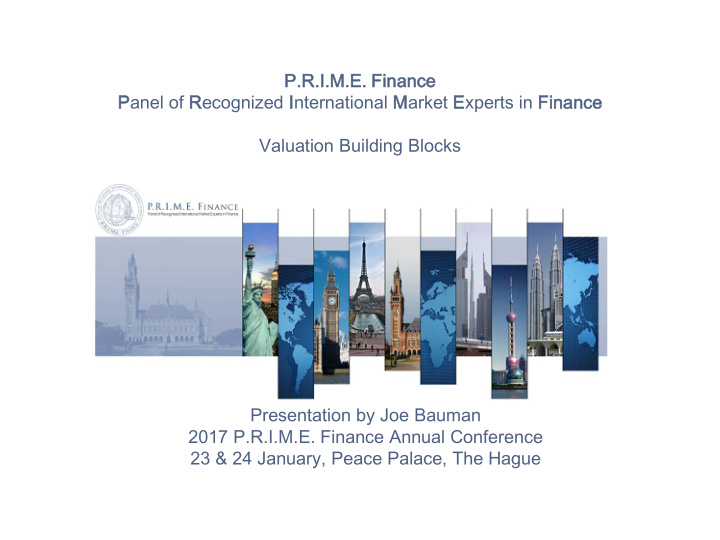



P.R.I.M. M.E. E. F Finance ce Panel of Recognized International Market Experts in Finan nance Valuation Building Blocks Presentation by Joe Bauman 2017 P.R.I.M.E. Finance Annual Conference 23 & 24 January, Peace Palace, The Hague
Fair Value vs. Close-Out Amount Fair Value: An Accounting Standard • The price that would be received to sell an asset or paid to transfer a liability in an orderly transaction between market participants at the measurement date. (ASC 820) Close-out Amount: The 2002 Master Agreement Standard • The amount of losses or costs that are or would be incurred under the prevailing circumstances…in replacing, or providing the economic equivalent of…the material terms of that terminated transaction. (2002 ISDA Master Agreement) Close-out Amount recognizes that replacement value may take account of markets that are not orderly, as well as liquidity, counterparty, and other risk factors. Valuation of any terminated transaction, even one subject to Market Quotation, should start with • consideration of the transaction structure relative to well-accepted financial building blocks.
Net Present Value – The Key Building Block • In theory, cash and derivative transactions entered into at market rates and prices have a net present value of zero at inception. • The net present value after transaction inception reflects the changes in value of known cash flows and volatilities of uncertain potential future cash flows, discounted to the valuation date. • Implicit is the creation of a discount factors derived from the forward interest rates of the valuation currency.
Net Present Value – The Key Building Block • For a plain vanilla interest rate swap, the NPV equals the sum of the present value differences between the remaining fixed cash flows of the defaulted transaction and the fixed cash flows required by a new transaction of matching terms to the maturity of the defaulted transaction. By Example: • Cash flows at inception of interest rate swap ($100mm NP / 5 year paid annually / 4% fixed vs. $ Libor) as shown below • Assume the fixed rate receiver defaults after two years of payments, with the replacement swap now at 6% fixed for three years
Net Present Value – The Key Building Block • The non-defaulting party calculates its loss as the net present value of replacement swap flows, based on discount factors reflecting the non-defaulting party’s cost of funds or investment rate curve Cash Deficiency Discount Factor PV of Deficiency – End of Year 3 $2.0m 0.9434 $1.8868m – End of Year 4 $2.0m 0.8900 $1.7800m – End of Year 5 $2.0m 0.8396 $1.6792m Net Present Value $5.3460m
Product Building Blocks • Virtually all derivatives are composed of one or more of three product building blocks. – Forwards – Swaps – Options • Many asset-based products, and virtually all “structured securities”, are combinations of the building blocks and “standard” loan and security products.
Product Building Blocks Forward: Single period settlement based on the difference at maturity in rates between the market rate and strike rate Buyer payoff against $100m 1 year 4% forward rate $m 4 Payoff 2 0 Strike Rate -2 -4 Rate at maturity (%) 0 2 4 6 8 •
Product Building Blocks Swap: A swap is simply a series of forward contracts $m Swap payoff against 4% fixed rate 4 2 0 -2 -4 0 1 2 3 4 5 6 Term •
Product Building Blocks Option: Grants the buyer the “right but not the obligation” to buy or sell an underlying product, rate, or index at a point in time in the future at a predetermined price in exchange for a premium paid to the seller.
Product Building Blocks • Options have asymmetric payoff characteristics, and are generally categorized by the buy/sell direction and put/call character (or floor/cap in interest rate terms)
Options Products – Volatility Explained • Options have been traded for centuries, but not until the 1970’s with the acceptance of the Black- Scholes model, was there a mathematical basis for the pricing of volatility – a major component of option value. • Intuitively, the higher the perceived volatility of a product price, rate, or index the higher the price (and value) of the option. Doubling the level of volatility will more than double the market value of an at-the-money option. Value of cap prior to expiration Option Value Option value Volatility component Option intrinsic value Market rate 0% 1% 2% 3% 4% 5% 6% 7% 8% 9%
Product Building Blocks Applied - Derivatives • Examples of how these products are combined: – Caps, collars, and floors – Combinations of interest rate puts and calls – Forward starting swaps – Spot-start swap for x years combined with a spot start reversing swap for (x-y) years – Amortizing swaps - Layering of spot-start swaps of various maturities that total to the desired principal amount at a blended single fixed rate – Swaptions - Options to enter into a forward starting swap of set maturity – Callable swaps - Spot-start swap with forward starting swaption expiring before the swap maturity – Extendable swaps - Spot-start swap with forward starting swaption expiring at swap maturity – Butterfly, condor, and other option structures - various combinations of caps (calls) and floors (puts) at different strike levels
Creating a Collar Transaction
Product Building Blocks Applied – Structured Securities • Most structured securities are created to meet investor demand and risk appetite – the security issuer’s interest is in a standard fixed or floating rate debt exposure – Mortgage loans - Embeds caps and floors into fixed rate loan structure – Credit linked and equity linked notes - Combines standard floating rate note with credit default swaps (essentially options on credit) or equity options – Inverse floating rate notes - Interest coupon increases with decreasing interest rates by embedding interest rate swaps within a standard note – Knock-out notes - Notes that may terminate early if a certain market rate trigger is reached. Created as a combination of a standard note and swaption.
Recommend
More recommend